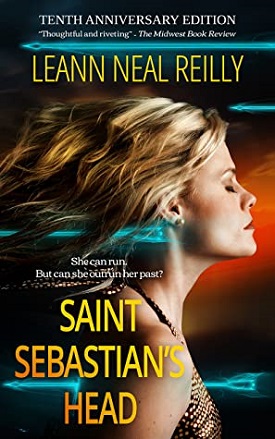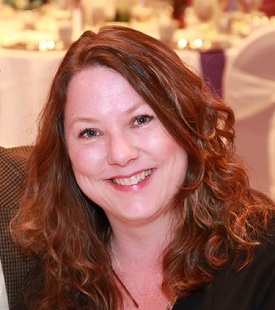 It’s a delight to LeAnn Neil Reilly back to Colloquium. She is the author of The Mermaid’s Pendant, a delightful re-imagined version of The Little Mermaid, as well as The Last Stratiote, a dark urban fantasy reimagining Charles Dickens’ classic A Tale of Two Cities.
It’s a delight to LeAnn Neil Reilly back to Colloquium. She is the author of The Mermaid’s Pendant, a delightful re-imagined version of The Little Mermaid, as well as The Last Stratiote, a dark urban fantasy reimagining Charles Dickens’ classic A Tale of Two Cities.
In 2011, Saint Sebastian’s Head was published, and has now been reissued. It’s the story of Weeble, whose childhood was so characterized by pain and trauma that she hides the details from everyone, including herself. When she was ten years old, she and classmate Lauren Case became friends. Lauren’s life was far different from Weeble’s, but they shared a love of reading. Lauren, her Grandma Nan, who was raising her, and their lovely home provided a safe refuge for Weeble from her drinking and drug-using parents who paid little attention to her or her little sister, Annie. Although Weeble tried to protect both Annie and Lauren, she was unable to stop the sinister and malevolent forces that ripped their lives apart. Four years after graduating from college, Weeble has the opportunity to be happy and loved just as she is. Can she acknowledge the truth about the past and forgive herself?
Celebrating the 10th Anniversary Edition of Saint Sebastian’s Head
by
LeAnn Neil Reilly
It’s been almost a decade since Saint Sebastian’s Head came out. It was my second novel, but the first one where I believed I’d hit my writing stride so to speak. I’m not even sure now what inspired me initially, but I know that I wanted to write something powerful, a story that had the ability to grab readers and make them think. Shock them even. To do that, I had to write something that pushed my boundaries, both in craft and in emotional authenticity. To write about a subject that disturbed and scared me if I looked at it honestly. And to write with a directness that made me wince.
Even before researching the history of serial killing for Saint Sebastian’s Head, I’d long wondered about the aftermath for those who either lost a loved one to a serial killer or had in fact survived an attack by a serial killer. How does one return to living life in any ordinary and recognizable manner? How does a victim or a grieving relative move on? That seemed like a reasonable sort of premise for a character-based novel, and entirely in the wheelhouse of a novelist, who is, after all, supposed to be able to understand and write about the human condition.
If I could imagine the answers to those questions, if I could put myself through it with as much empathy as I could muster, then I believed that I could help others imagine what it was like as well. As I began musing over the story idea, I listened to Ann Rule’s The Stranger Beside Me on audiobook. Two things became clear to me at that point: 1) I didn’t care one whit what went on in Ted Bundy’s mind that allowed him to work at a rape crisis hotline next to Ann while stalking co-eds to murder, and 2) his story lives on in infamy while each of his victims are unknown. That broke and continues to break my heart.
So I was never going to get into the mind of a serial killer like Richard Lee Grady, the fictional killer in Saint Sebastian’s Head. His motives were alien to me, so I left him a cipher and reported on him in the most objective manner I could. Yet I believe that murder is part of the human condition. As a fiction writer, I’m pretty sure that I can push myself to imagine killing someone, either out of anger or fear and either premeditated or spontaneously. In fact, the dark heroine of my third novel, The Last Stratiote, transforms into a vampire on an endless quest for blood vengeance after an assault. It’s no coincidence that I planned and researched Elira’s story while writing Weeble’s: Elira is Weeble if she could take all of her rage, grief, and loss and channel them into effective murderous action.
But, like Weeble, I have been circling around the real issue.
How much of Weeble is me? How much of Weeble’s story is mine? Does it matter? Because the whole story is fiction. If it rings true, it’s because I didn’t declare anything off limits to my imagination and my heart, including real details that I felt free to modify and transmogrify as my vision of Weeble’s journey necessitated. If it moves readers, does that mean they recognize something of themselves or people they know in the story? If so, that’s a good thing. And Weeble might say that even though they are older, wiser, and sadder after reading, they have been led a little closer to the light.
Meet LeAnn

LeAnn Neal Reilly graduated from Carnegie Mellon University with a master’s degree in professional writing. Along the way, she majored briefly in chemistry, served as opinion editor and editor of her college newspaper, and interned for an international design firm. After graduate school, LeAnn worked for a small multimedia startup and a computer science research group. At the startup, she spent her time writing user manuals and scripts for multimedia software used to train railroad engineers.
Technical writing caused LeAnn to became enamored and she decided to take one home for herself. After getting married and starting a family, she returned to her adolescent daydreams of writing novels. She wrote for many years in an office not much more glamorous than an unfinished closet, and eventually published The Mermaid’s Pendant.
LeAnn says her biggest fear is public speaking. Her favorite authors are Shakespeare and Jane Austen, and if she could only take three books with her to a desert island, she would pack her copy of Shakespeare’s complete works and a collection of Austen’s novels.



4 Comments
This book sounds captivating and fascinating. The author is extremely talented and worked hard to write this amazing book.
This book sounds like it will draw the reader in and be impossible to put down.
I read Saint Sebastian’s Head when it was first released and it got me thinking. The main character’s life was so foreign to anything I knew growing up, and yet as I age I realize how different everyone’s life experiences are. When I meet someone new, despite outward appearances I must not assume I know where they are coming from, because their history might be very different from my own. Accounts like this give me an additional perspective. This book kept me engaged – I had to keep reading to find out how it ended!
Great write up book sounds great